Elephant¡¯s move
C-xiangbu fei (ßÚÜÆÞ«)
Chinese ¡®ßÚÜÆÞ«¡¯ which means ¡®large diagonal move¡¯ that looks the same as move of elephant in Chinese chess.
We can find this kind of coinage also in ¡®knight¡¯s move.¡¯
See large diagonle
Empty triangle
J-akisankaku (Íöªß²ÊÇ), C-kong sanjiao (Íöß²ÊÇ)£¬K-ºó»ï°¢
A shape made by the three black stones in Dia. 1.
It is called ¡®empty¡¯ because the intersection at ¡®a¡¯ is not filled.
 Dia. 1
Dia. 1
It is usually considered to be an inefficient and bad shape, but sometimes it can be a good move as shown in Dia. 2.
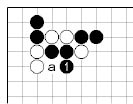 Dia. 2
Dia. 2
Empty corner
J-akisumi (Íöéê), C-kong jiao (ÍöÊÇ), K-ºó ±Í
A corner where no stone has been played yet.
Enclose (a corner)
J-shimaru (ôóªÞªë), C-shoujiao (áúÊÇ), K-±»È÷´Ù
To secure a corner area by placing stone(s) near to a friendly stone already located in that corner.
Literally the Japanese term ¡®shimaru¡¯ means ¡®to close up,¡¯ the Korean ¡®±»È÷´Ù¡¯ means ¡®to harden or to consolidate¡¯ and the Chinese ¡®shou jiao¡¯ means ¡®to defend a corner.¡¯
Although the term ¡®enclose¡¯ can be applied to all the moves that secure territory by surrounding a certain area, in Go it is used exclusively in a corner situation.
Diagonal enclosure
No J, C-xiaojian shoujiao (á³ôÓáúÊÇ), K-¸ð±»Èû
 Dia. 1
Dia. 1
Black 1 in Dia. 1 defends the corner with a diagonal move from the stone on the 4-4 point.
Knight¡¯s enclosure
J-kogeima shimari (á³ÌýØ©ôóªê), C-xiaofei shoujiao (á³?áúÊÇ), K-³¯ÀÏÀÚ ±»Èû
 Dia. 1
Dia. 1
Black 1 in Dia. 1 defends the corner with a knight¡¯s move from the 3-4 point.
Large knight¡¯s enclosure
J-ogeima shimari (ÓÞÌýØ©ôóªê), C-dafei shoujiao (ÓÞ?áúÊÇ), K-´«¸ñÀÚ ±»Èû
 Dia. 1
Dia. 1
Black 1 in Dia. 1 defends the corner with a large knight¡¯s move from the 3-4.
Endgame
J-yose (Ðöª»), C-guanzi (ίí), K-³¡³»±â
A series of moves that ultimately decides the outline of territory.
It is usually played at a closing stage as the term itself says, but also can be played at any time during a game.
It is possible to gain points through good endgame play; it is also possible to loss points through bad endgame play. Therefore, good endgame technique can be important in the closing stage where there are chances for profit or for loss in a game that is very close.
Eternal life
J-chosei (íþßæ), C-changsheng (?ßæ), K-Àå»ý (íþßæ)
One of the super ko.
The Chinese íþßæ literally means ¡®a long life.¡¯ It is so called because it repeats capture and recapture. Black plays 1 to kill the surrounded White stones in Dia. 1. White cannot capture Black 1 with 2 in Dia. 2, because his stones will then die after Black makes a dead five-point eye space with. Therefore, White will play 2 as in Dia. 3, and Black takes two white stones with 3. After White 4 and Black 5, it reverts to Dia. 1. This repetition will continue unless one of the players stops. In that case, the rules state that the game is ¡®no result,¡¯ and the players must play again.
 Dia. 1
Dia. 1  Dia. 2
Dia. 2
 Dia. 3
Dia. 3  Dia. 4
Dia. 4  Dia. 5
Dia. 5
Even game
J-tagaisen (û»à»), C-huxian (û»à»)£¬K-È£¼± (û»à»)
A handicap rule of alternating Black and White, which is applied when players have equal strength.
In an even game, Black has to give compensation to White in exchange for the advantage of playing first.
The literal meaning of ¡®û»à»¡¯ is ¡®to take turns playing first.¡¯ In the past it didn¡¯t imply giving compensation.
Exchange
J-kokan (Îßüµ), C-jiaohuan (Îß?), K-±³È¯ (Îßüµ)
To proceed with a set of moves before playing an important move or turning elsewhere, when the result of the moves can be expected by both players.
Cf. trade
Expand
See extend, stretch
Extend
J-hiraku (ËÒª¯), C-chai (?), K-¹ú¸®´Ù
To lengthen a framework by playing a move on the third or the fourth line along the side.
 Dia. 1
Dia. 1  Dia. 2
Dia. 2
Cf. stretch
One-space extension
 Dia. 1
Dia. 1
Two-space extension
 Dia. 2
Dia. 2
Three-space extension
 Dia. 3
Dia. 3
Extra-defense
No J, no C, K-°¡Àϼö (ʦìéâ¢)
To spend an extra, non-urgent move and suffer by ending in gote in order to erase potential trouble in one¡¯s own position and guarantee safety.
 Dia. 1
Dia. 1
Black 1 in Dia. 1 can be called an ¡®extra-defense.¡¯ It prevents White from invading at ¡®a,¡¯ but is not compulsory. There is ¡®potential erasure¡¯ as an opposite concept to it. See potential trouble.
Eye
J-me (äÑ), C-yan (äÑ), K-´«
An empty space or intersection where the opponent can neither play on nor force it to be filled.
As a rule, stones on the board can live when they have two separate eyes. The three Asian terminologies commonly have the metaphoric term ¡®eye.¡¯
 Dia. 1
Dia. 1
¡®A¡¯ is the simplest form of an eye.
Break an eye
J-me kuzure ( äÑÝÚªì), C-po yan (÷òäÑ), K-ÆÄÈ£(÷òûÂ)ÇÏ´Ù
To prevent the opponent¡¯s eye shape from being an absolute eye and cause the stones having the eye shape difficulty in living.
 Dia. 1
Dia. 1
White 1 and 3 in Dia. 1 both are moves that breaks the opponent¡¯s eye.
Eye shape
J-gankei(äÑû¡), C-yanxing (äÑû¡)£¬K-¾ÈÇü (äÑû¡)
A shape with which one can make an eye or eyes.
 Dia. 1
Dia. 1
The white stones would seem to die if Black plays ¡®a¡¯ or ¡®b.¡¯ However, if Black plays on one of them, White will play on the other and make an eye. The white stones in Dia. 1 have lots of eye shapes in it.
Eye Space
No J, C-yanwei (äÑêÈ), K-±Ãµµ (ÏàÓñ)
A space inside of a group available to make an eye or eyes.
It only matters when a group is completely surrounded and a space in the group is not big enough to live easily. The possibility of living depends not only on the size of the eye space but also on its shape, as can be seen in the case of ¡®square four¡¯ and ¡®straight four.¡¯
Eye vs. No Eye
J-mearimenashi (äѪ¢ªêäѪʪ·), C-youyan sha wuyan (êóäÑ?ÙéäÑ)£¬K-À¯°¡¹«°¡ (êóÊ«ÙíÊ«)
A capturing race in which only one side has an eye.
The side with one eye will win the race if the other side has no eye.
 Dia. 1
Dia. 1  Dia. 2
Dia. 2
Although the four white stones in the corner in Dia. 1 seem to be dead, Black can¡¯t capture them, so his stones will die. Even if Black fills the internal liberties with marked stones and Black 1, after White fills the external liberty with 2, he cannot put the four white stones into atari.
Facing 3-4 points formation
J-mukaikomoku (ú¾ª«ª·á³ÙÍ), C-xiangxiaomu (ú¾á³ÙÍ)£¬K-Çâ¼Ò¸ñ (ú¾á³ÙÍ)
An opening in which one player occupies two 3-4 points on one side of the board, placing them farthest from each other, as White 2 and 4 in Dia. 1.
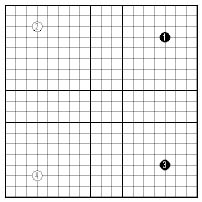 Dia. 1
Dia. 1
Black can naturally approach only on the left side, not on the side facing Black 1 or 3. As a result, neither player can form a large framework of territory and the board will be divided into several parts.
Fighting 3-4 points formation
J-kenkakomoku (ý½?á³ÙÍ), no C, no K
An opening style in which each player occupies 3-4 points confronting each other on one side of the board as White 2 and Black 3 in Dia. 1.
 Dia. 1
Dia. 1
This also can be a strategem for Black to occupy three empty corners. Against Black 3, if White takes the lower right corner as in Dia. 1, then Black¡¯s approach at 5 is a good move. Therefore. White often uses his move of 4 to approach the black stone at 3. This is also a good move, but Black would then be able to occupy the last empty corner with 5 in Dia. 2.
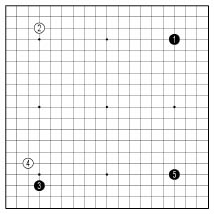 Dia. 2
Dia. 2
The Japanese ¡®kenka (ý½?) literally means a ¡®quarrel¡¯ or ¡®fight¡¯ and the Japanese terminology distinguishes this from the ¡®facing 3-4 points formation (mukaikomoku).¡¯ There is no equivalent word for it found in the Korean and the Chinese terminology.
False eye
J-kakeme (ý⪱äÑ), C-jiayan (Ê£äÑ)£¬K-¿ÁÁý
An empty point which looks like a real eye but isn¡¯t because that point must eventually be filled or the opposing side will occupy that point by capturing some stones.
 Dia. 1
Dia. 1
The black stones in Dia. 1 seems to have two separate eyes. However, the point ¡®a¡¯ is not an eye because Black has to connect that point when the two marked points are filled. The Japanese ¡®kageme¡¯ means a ¡®shadow eye.¡¯
Farmer¡¯s hat
J-jingasa (òæØ¢), C-dingsi (ïËÞÌ), K-»ñ°«Çü
A pyramid shape of four black stones shown in Dia. 1.
It is a bad shape because it is a combination of two empty triangles.
 Dia. 1
Dia. 1
Fighting spirit
J-kiai (?ùê), C-qihe (?ûú)£¬K-±â¼¼ (Ѩá§)
The attitude where a player is determined to win and plays all out.
The player with the fighting spirit doesn¡¯t allow the opponent to lead a situation as he plans.
Fighting 3-4 points formation
See facing 3-4 points formation.
Flat
Floating stones
J-ukiishi (Ý©ªà´), C-fuzi (Ý©í)£¬K-¶á µ¹
Unsettled, especially when a group of stones doesn¡¯t have a base in a corner or on a side.
 Dia. 1
Dia. 1
The three white stones in Dia. 1 are an example of floating stones, because it is hard for them to make a base at the top.
Flower four
No J, C-dingsi (ïËÞÌ), K-²É»ç±Ã
A four-point eye space shown in Dia. 1 which can be killed if White plays at ¡®a.¡¯
 Dia. 1
Dia. 1
There is no Japanese equivalance for this term. The entry is translated from the Korean ¡®²É»ç±Ã.¡¯ ¡®²É¡¯ means literally ¡®flower.¡¯ The Chinese terminology has a common name, ¡®dingsi,¡¯ covering this shape and ¡®farmer¡¯s hat¡¯ as well.
Flower five
J-hana gomoku (ü£çéÙÍ), C-meihua wu (ØÞü£çé), no K
A name for the eye shape of five points shown in Dia. 1.
 Dia. 1
Dia. 1  Dia. 2
Dia. 2
The Japanese ¡®hana gomoku¡¯ also refers to the Black¡¯s shape in Dia. 2.
Flower point
See star point
Flower six
J-hanaroku (ü£ë»), C-juliu (ö©×¿)£¬K-¸ÅÈÀ°±Ã (ØÞü£ë»Ïà)
The six-point eye space shown in Dia. 1 which can be killed if White plays at ¡®a.¡¯
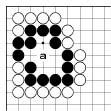 Dia. 1
Dia. 1
The Chinese ¡®ju (ö©)¡¯ is a prefix meaning ¡®poly.¡¯ Therefore the Chinese ¡®ju liu (ö©×¿)¡¯ means ¡®conglomerated six¡¯ while the Japanese ¡®hana (ü£)¡¯ means just a ¡®flower¡¯ and the Korean ¡®¸ÅÈ (ØÞü£)¡¯ mean ¡®cherry blossom.¡¯
Fool¡¯s eight (in the corner)
J-bakahachi (ªÐª«ø¢), no C, no K
A two-by-four eye space in the corner that becomes a dual life.
 Dia. 1
Dia. 1  Dia. 2
Dia. 2  Dia. 3
Dia. 3  Dia. 4
Dia. 4
The Black stones in Dia. 1 seems to have eight points of territory, but, when White invades with 1 in Dia. 2, the situation changes. If Black answers with 2, the corner becomes a ko. In this case, Black 2 in Dia. 3 is a correct move to avoid a ko, but it can still become a ko if Black blocks with 4. The only way that Black can live without a ko is to play 4 and 6 in Dia. 4 and make a dual life, but the eight points in the corner become nothing.
 Dia. 5
Dia. 5  Dia. 6
Dia. 6
Therefore, in Dia. 5 Black should not make the fool¡¯s eight, but instead make two separate eyes by playing 1 in Dia. 6.
Forcing move
J-kikashi (즪«ª·), C-shi yingshou (??â¢)£¬K-(¼±¼ö(à»â¢)¸¦) È°¿ë(üÀéÄ)ÇÏ´Ù
A move which requires an answer by the opponent and gains some advantage even if not followed up immediately.
The side that plays it can gain a lot with follow-up moves when the opponent ignores it.
 Dia. 1
Dia. 1
Black 1 in Dia. 1 forces White to answer with 2. Black would not play any futher moves here, but play elsewhere. This exchange of Black 1 and White 2 doesn¡¯t seem to mean a lot, but owing to this exchange, Black can attack the white stones with ¡®a¡¯ or ¡®c,¡¯ or make influence with ¡®b.¡¯ The purpose of Black 1 is not to get an immidiate result, but to leave open these possibilities.
The three Asian terms have the common literal meaning of ¡®to utilize the situation to the utmost.¡¯ It means that a player makes all possible moves requiring the opponent¡¯s answer, if the moves are harmless to his own stones.
Four Accomplishments
J-kinki shoga (ÐÖѤßöûþ), C-qinqishuhua (ÐÖѤßöûþ), K-±Ý±â¼È (ÐÖѤßöûþ)
Go (Ѥ) was considered one of the Four Accomplishments in ancient China, one of the worthy pursuits of life - along with poetry (ßö), lute playing (ÐÖ), and calligraphy (ûþ).
Framework
J-moyo (Ù¼åÆ), C-moyang (Ù¼åÆ), K-¸ð¾ç (Ù¼åÆ)
A territorial outline, made up of several strategic points that can become actual territory as the game continues.
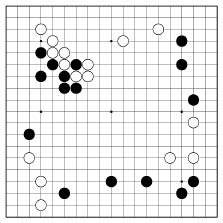 Dia. 1
Dia. 1
In the diagram above, Black and White have built frameworks that share the board.
Game of peace
No J, C-heqi (ûúѤ), K-ȱ¹ (ûúÏÑ)
A knickname for the game that ends with both sides having the same amount of territory.
It is just after 20c that a half a point was invented to avoid a game resulting tie. It was called as this in the past and was considered a good omen.
Game record
J-kifu (ѤÜÏ), C-qipu (Ѥ?)£¬K-±âº¸ (ѤÜÏ)
A diagram that shows the moves of a game.
Go
J-igo (?ѳ), C-weiqi (êÌѤ), K-baduk
The international name of the game.
It comes from the Japanese pronunciation of ¡®Ñ³.¡¯
Godokoro (J)
J-ѳá¶
An official post taking responsibility for professional go affairs in the Edo period of Japan.
The person who took this position had to be the strongest player of the day.
Go Seigen pattern
çïôèê¹ ïÒà´
A pattern in the Large Avalanche which was invented by the Chinese-Japanese 9 dan professional, Go Seigen (çïôèê¹.)
It is characterized by Black 1 in Dia. 1. Previously Black 1 had only been at ¡®a.¡¯
 Dia.1
Dia.1
Go Saint
J-kisei (Ѥá¡) / gosei (ѳá¡), C-qisheng (Ѥ?), K-±â¼º (Ѥá¡)
An accolade given to a player whose strength far exceeded all other players of his generation.
Gote (J)
J-gote (ýâ¢), C-houshou (ý¨â¢)£¬K-Èļö (ýâ¢)
1. A move which does not require the opponent¡¯s answer.
2. A position in which one is forced to answer the opponent¡¯s last move.
Gote endgame
J-gote yose (ýâ¢Ðöª»), C-houshou guanzi (ý¨â¢Î¯í), K-Èļö ³¡³»±â
An endgame move that ends in the player¡¯s gote.
Unilateral gote endgame
J-kata sente (ø¸à»â¢), no C, K-ÆíÈļö(ø¸ýâ¢)
An endgame that results in gote and affects the size of only one player¡¯s territory.
 Dia. 1
Dia. 1
It is a unilateral gote endgame for Black to play at ¡®a¡¯ in Dia. 1 since it affects just Black¡¯s territory.
Cf. unilateral sente endgame, reverse sente.
Bilateral gote endgame
J-ryo gote (å»ýâ¢), C-shuang hou (?ý¨), K-¾çÈļö(å»ýâ¢)
An endgame that results in gote and affects the size of the territory of both the players.
 Dia. 1
Dia. 1  Dia. 2
Dia. 2
Gouge out
J-eguru (̼ªë), C-tou dian (÷âïÃ), K-ÆÄ´Ù
To cut out a big part of opponent¡¯s territory usually from underneath.
It is said only when the part reduced is relatively large to the original territory.
 Dia. 1
Dia. 1  Dia. 2
Dia. 2
In diagrams above, White succeeds in gouging out Black¡¯s base from 1 to 7.
Great Slant pattern
J-taisha (ÓÞÞØ), C-daxie (ÓÞÞØ)£¬K-´ë»çÁ¤¼® (ÓÞÞØïÒà´)
A 3-5 point pattern beginning with Black 1 in Dia. 1.
It is known as the ¡®pattern of a thousand variations¡¯ and is commonly regarded as one of the most difficult to master. The name ¡®ÓÞÞØ¡¯, literally ¡®great slant,¡¯ arises from the large knight¡¯s move of Black 1 in Dia. 1.
 Dia. 1
Dia. 1
The sequence shown below is one of its variations.
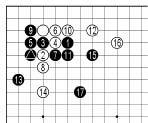 Dia. 2
Dia. 2






